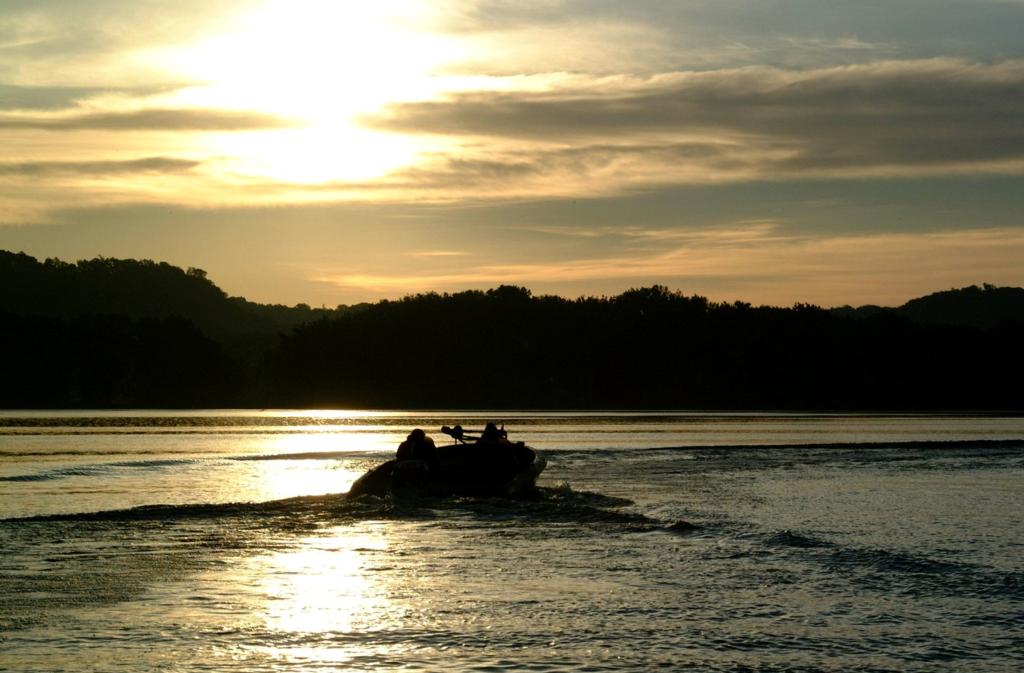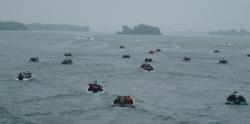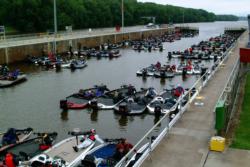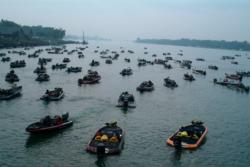2005 EverStart Series preview: Northern Division
New venues promise exciting action for this season’s Northern tournaments

Although the EverStart Series Northern Division may be visiting the Detroit River twice this year, the schedule, in fact, promises fresh, exciting bass fishing for its anglers and fans this season. The Detroit River tournaments bookend the season, offering two completely different events due to the changing seasons in between. New events slated this season include a tournament on the Mississippi River in Wisconsin and a trip to Lake Michigan on the Escanaba Bay, an event that promises groundbreaking action that will likely put Escanaba on the map for good. Here’s a look at what to expect from the Northern Division this season:
Detroit River
Trenton, Mich.
July 20-23
 The EverStart Series Northern Division will kick off the season at one of its most prolific bass-catching destinations – the Detroit River. As anyone familiar with the Detroit River knows, that also means making the journey to the Western Basin of Lake Erie, heralded nationwide for its high numbers of feisty smallmouths.
The EverStart Series Northern Division will kick off the season at one of its most prolific bass-catching destinations – the Detroit River. As anyone familiar with the Detroit River knows, that also means making the journey to the Western Basin of Lake Erie, heralded nationwide for its high numbers of feisty smallmouths.
According to pro angler Art Ferguson of nearby St. Clair Shores, Mich., the month of July opens up the entire Detroit River system, meaning competitors will have no trouble catching solid stringers of bass.
“That’s a really good postspawn time of year, when the fish are in a summer pattern,” Ferguson said. “They bite in the river itself, or you can go to Lake St. Clair or Erie or even the St. Clair River. It really opens up a lot of water. There are going to be several different patterns that time of year, depending on what part of water you go to.”
Indeed, the possibilities are practically limitless, but Ferguson recommends a topwater pattern for summertime Detroit River fishing.
“There’s a 95-percent chance the tournament will be won with smallmouths, so you’ll be throwing smallmouth-type lures like topwater baits, jerkbaits and some spinnerbaits,” he said. “Tube baits are always a key bait that time of year. There are several patterns, though – you could write a book on it.”
According to Ferguson, topwaters will be most effective in the early hours of the tournament day, followed by a tube bait or a fluke.
The fish in the Detroit River system will have moved out to deeper water by the time the tournament rolls around, and water levels should still be up due to snowfall amounts this past winter as well as springtime rains.
“All the Great Lakes are up right now,” Ferguson said. “That could be a good thing. The fish are less vulnerable in the clear water because it’s a little bit deeper. They’re easier to catch with the deeper water.”
Depths will of course vary depending on where one plans to fish. For Detroit River anglers, look for fish to be in the 5- to 15-foot range. If Lake Erie is in your plans, look for fish at depths of 18 to 25 feet, with 10 to 18 feet a good range for Lake St. Clair.
“The Detroit River has a lot of rocks, a lot of grass and a lot of current,” Ferguson said. “Out in the lakes, you’re looking at fishing isolated grass beds and rock piles and deeper structure. There are quite a few fish suspended, and they are chasing forage.”
Although most people would consider any time a good time to fish the Detroit River, July boasts some of the most stable weather conditions the area sees all year – a benefit to those hoping to avoid the large waves that a heavy wind can generate on massive Lake Erie.
The calm winds and steady conditions complement the warm air temperatures, which will likely fall somewhere in the 80s. Weather permitting, Ferguson believes the winning angler could weigh in as much as 36 to 40 pounds over two days.
Mississippi River
Onalaska, Wis.
Aug. 3-6
 Next up for Northern Division competitors is a stop on the Mississippi River in Wisconsin, a state not recently visited by the EverStart Series. One angler glad to see its return is Wisconsin pro Tom Monsoor, a veritable Mississippi River connoisseur.
Next up for Northern Division competitors is a stop on the Mississippi River in Wisconsin, a state not recently visited by the EverStart Series. One angler glad to see its return is Wisconsin pro Tom Monsoor, a veritable Mississippi River connoisseur.
Monsoor is also enthused about the tournament’s time frame – its early August date is perfect, he says, for catching good numbers of bass on about any lure that strikes your fancy. Look for swimming jigs, rats, tubes and Carolina-rigged baits to be productive in the warm August sun.
“The fish will be starting to school up,” he said. “When you catch one, there’s a good chance you’re going to catch 10, 20 or 30. They’ll be biting on everything. They’ll be in the lily pads, they’ll be on wood, they’ll be out in the back bays … there are so many different kinds of cover to fish that anyone who comes here will be catching fish doing what they like to do.”
In August, the Mississippi River bass will be well into their summertime pattern, not only schooled up but also feeding heavily on shad. Monsoor reports that the crystal-clear water is stocked with weeds that the fish will likely be found in or near.
“August and September are two of the most fun times to fish the Mississippi River,” Monsoor said. “Everything’s stable, and the fish are getting into patterns where if you figure out something, it’s going to keep working. The water conditions are always really good, and weeds will be the biggest thing, although there will be a lot of fish caught on wingdams, too.”
Anglers will also have their pick of depths to fish from, with 30 to 50 feet of fishable water in the main channel as well as 5 to 6 feet in the backwaters, though the 5- to 6-pound smallmouths will probably be lurking in the deep-water wingdams. An average bass, Monsoor said, probably weighs between 2 1/2 and 4 pounds.
Monsoor says the Onalaska area of the Mississippi and its surrounding lakes has a roughly equal population of both smallmouths and largemouths for anglers to catch. Fifteen pounds is a good stringer, with those in contention likely bringing in slightly more.
“It’s everybody’s ballgame that time of year,” Monsoor said. “It’s going to be unreal; people are going to flip out. It’s one of the best fisheries I’ve ever seen.”
Like many Northern fisheries, the Mississippi River bass benefit from the small fishing season due to the chilly weather at the beginning and end of each year. With about six months of fishing time eliminated, the bass get the chance to grow, spawn and eat without much disturbance.
“Plus they’re dumb,” Monsoor said of the river system’s fish. “That’s what really makes it fun – there’s nothing more fun than fishing for dumb fish.”
Lake Michigan
Escanaba, Mich.
Aug. 24-27
For the first time, the EverStart Series will make its mark on the Escanaba area of Lake Michigan this season, an area well-known for its walleye fishing but heretofore unheralded for its bass bite. That said, anyone who thinks this walleye-fishing destination isn’t also chock-full of smallmouth bass should think again, says Northern Division pro Mark Zona of Sturgis, Mich.
“It’s the best one on the tournament schedule,” Zona said. “It will be a catch fest.”
If the Escanaba Bay is such a great bass hole, why doesn’t anybody know about it? According to Zona, that is precisely what makes its bass so prevalent, although that could all soon change once news gets out about the 40-pound winning two-day stringer.
“It’s going to show itself as one of the premier smallmouth fisheries that week, bad weather or good weather,” Zona said. “It’s not a normal tournament site – the fish are not conditioned to tournaments. If the winds are light, I think it could be one of the biggest weight tournaments we’ve seen.”
Like many tournaments held on the Great Lakes, the wind will be a decisive factor during the Lake Michigan event. It is the second-largest of the five Great Lakes and covers more than 1,600 miles of shoreline – plenty of water to generate massive waves if the wind is high.
“The wind is going to be the biggest factor,” Zona said. “If you get heavy south winds, it’s going to be rockin’. The dream is to go there and have light, variable winds for a week, but that doesn’t happen on the Great Lakes.”
Zona says Northern anglers – particular Erie veterans – who are used to the wind will likely still bring in huge sacks whether the wind blows or not. If the winds are light, then virtually everyone will be hauling in heavy stringers.
“The neat thing about Escanaba is, if the winds do not blow, you can catch them any way you want,” Zona said. “That’s what’s going to be really unique. Power fishermen will shine and so will deep-water finesse fishermen. If you’re able to get out and the wind doesn’t hold you back, it will take a 4-pound average to win that event.”
With the area’s extreme Northern climate, the bass in Escanaba do not spawn until July, meaning by the tournament’s August time frame, the bass will just be finishing up with the spawn. Zona says fish can be caught in 3 feet of water or 30 feet of water – whatever an angler prefers.
“It’s different from Lake Erie and Lake Ontario,” Zona said. “Those lakes you can catch them dragging, but you can catch them in Escanaba really shallow too – spinnerbaiting, jerkbaiting. That time of year, a lot will be caught shallow.”
Zona also reports that Lake Michigan is much clearer than some of the other Great Lakes, with clarity down to 20 or 30 feet. He also says that versatility is key on Lake Michigan – hole-sitting will probably not win you the tournament.
“The guys who do well are going to have different areas in different parts of the lake – on the east side, the west side and the northern side,” Zona said. “They’ll adjust accordingly to that. If there are light winds, it’ll be a slugfest.”
Zona predicts anglers will need 16 to 18 pounds to make the cut and an average of 20 pounds per day (weather permitting) to claim the win.
Detroit River
Trenton, Mich.
Sept. 21-24
 When the Northern Division returns to the Detroit River in late September, look for river fishing to be the key, as the bass will be looking for current due to the onset of cooler weather.
When the Northern Division returns to the Detroit River in late September, look for river fishing to be the key, as the bass will be looking for current due to the onset of cooler weather.
According to 2004 Detroit River winner Jim Liechty, some smallmouths will be migrating toward the Canadian shoreline, and competitors fishing the lakes may still be able to find them on certain shoals.
But the real deal in the fall is the mouth of the Detroit River, says Liechty. “As it starts cooling down, the fish start migrating back up toward the mouth of the river and the flats surrounding the mouth,” he said. “The fish will be really active in shallow water, where they’ll school up in key spots.”
When the weeds start dying off as fall begins and winter approaches, the fish start looking for current. They will then bunch up on rock piles and become quite active. The best depth range is 2 to 7 feet at the mouth of the river.
“It could be fantastic fishing,” Liechty said. “It’s one of the more exceptional times to be fishing up there. It’s just getting on the right deal, but I think it’s going to take some big bags.”
As usual, Liechty predicts the tube bait will be the best fish-catcher on the Detroit River system. He also recommends slow-moving baits and says that when the smallmouths begin to get pretty active, then spinnerbaits and crankbaits can be effective in the mouth of the river.
In late September, the Detroit area is likely to experience a range of weather conditions, with air temperatures expected to fall anywhere between 45 and 60 degrees.
“It could be fairly unpredictable,” Liechty said. “A lot of it will depend on the weather as to where the best fishing will be, so it’s not going to be a set deal.”
With the quantity and quality of the Detroit River smallmouths, Liechty believes it will take at least three 4-pounders to make a mark. He expects the winning two-day stringer to total around 36 to 38 pounds.